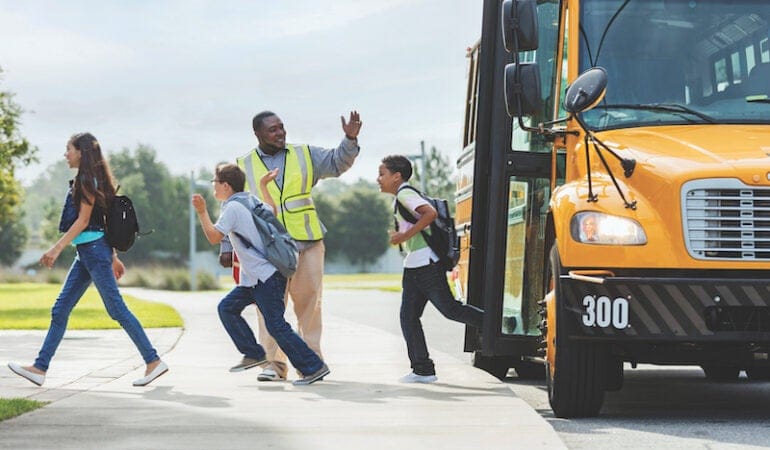
How State Aid and Local Property Taxes Can Together Fund Quality Education for All Students
Local property taxes and state aid each have flaws, but a thoughtful combination of these two revenue sources is the most effective recipe for funding a high-quality K–12 education for all students, according to a new Policy Focus Report published by the Lincoln Institute of Land Policy.
In Rethinking the Property Tax–School Funding Dilemma, authors Daphne A. Kenyon, Bethany Paquin, and Andrew Reschovsky explain how local property taxes foster civic engagement and provide stable funding, while state aid is critical in reducing disparities among school districts caused by differing levels of property wealth and differences in the money needed to provide high-quality education.
The report explains the advantages of the property tax compared to other local taxes and demonstrates how states can adopt policies to address criticism of the property tax. A well- designed system of state aid can offset differences in per-pupil property values and in the costs of providing quality education. State-funded property tax credits can reduce economic hardships for taxpayers facing high property tax burdens, especially those with low incomes. And unjustified differences in property tax bills among owners of similar properties can be addressed through more frequent and accurate assessments. The authors explain why the majority of states still fail to provide all students an adequate education and recommend policies to strengthen both funding sources with the specific goal of improving student outcomes.
Five state-level case studies illustrate the practical nuances of state education finance and property tax policies and offer important lessons for policy makers. California’s Proposition 13 limited property taxation and accelerated a shift toward state funding at the expense of local control and student academic performance. A more modest property tax limit in Massachusetts proved more flexible and, combined with targeted state aid and robust accountability standards, has not impeded strong academic results.
South Carolina’s implementation of a local-for-state tax swap in 2007, which fully exempted homeowners from paying local school property taxes and increased reliance on the sales tax to fund education, demonstrated how unreliable sales taxes can be in an economic downturn. Despite a long history of school funding litigation, Texas still relies heavily on property taxes to fund its schools. Failure to continually adjust its state funding formula for rising costs and property values has led to higher property tax burdens on homeowners. Last, in Wisconsin, the state’s property tax revenue limit restricts school districts’ ability to increase spending, and the state equalization aid formula does not account for differences in school districts’ needs and costs.
“As a former state education official, I would have loved to have had a report like this to help me get up to speed on the critical issues around school finance policy,” said Carrie Conaway, former chief strategy and research officer at the Massachusetts Department of Elementary and Secondary Education and senior lecturer at the Harvard University Graduate School of Education. “The report provides a very clear explanation of the role played by the property tax in funding public education and describes the complex issues involved in designing effective state aid systems. Anyone involved in or interested in school funding policy will benefit from reading this report.”
“A perennial target in state education finance legislation, the property tax remains a much-discussed and asked-about topic in my work with state legislatures,” National Conference of State Legislatures Senior Fellow Daniel G. Thatcher agreed. “This report will guide policy conversations about how to improve the sustainability, stability, and fairness of property tax systems, and also in education finance systems writ large.”
Rethinking the Property Tax–School Funding Dilemma offers specific reforms that state governments—as well as localities—can make to balance revenue needs, funding realities, and other considerations. Notably, states must resist calls to stop using local property taxes to fund schools while also improving the equity and efficiency of their property tax systems.
The authors also recommend that states maintain sufficient “rainy day funds” to draw upon when state tax revenues decline and that they target more local aid toward schools that require additional support to provide their students with an adequate education. Finally, the federal government also has a role to play in supplementing funding in low-spending states according to need, as well as in helping remedy learning losses from the COVID-19 pandemic.
“Understanding the relationship between local property taxes and state school aid is critical for understanding how public schools are funded,” said Lawrence O. Picus, professor of education finance and policy at the University of Southern California Rossier School of Education. “This Policy Focus Report provides concise guidance about the use of property taxes and the importance of state funds to equalize disparities in property tax revenues for schools. It is a must-read for anyone interested in, or part of, the school finance policy process, and an excellent introduction for those who want to dig deeper into these relationships.”
While specific reforms will necessarily vary across different states and localities, the authors stress that targeting state education funding is essential in closing equity gaps and overcoming the persistent effects of the COVID-19 pandemic and their disproportionate impact on students of color, English-language learners, and disabled students.
Equally important is a well-functioning property tax system that avoids overly burdensome restrictions while offering “circuit breakers” and other forms of targeted relief to homeowners in need. Ultimately, the authors offer readers the tools for “overcoming the shortcomings of both funding sources, enabling state school funding systems to give all students an adequate, quality education equitably and efficiently.”
The report is available for download on the Lincoln Institute’s website: https://www.lincolninst.edu/publications/policy-focus-reports/rethinking…
Allison Ehrich Bernstein is principal at Allative Communications.
Image by kali9 via Getty Images.
